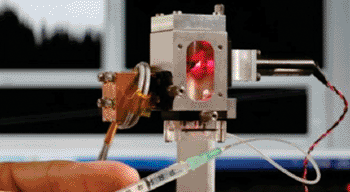Nanomechanical Sensors Detect Antibiotic Resistance
By LabMedica International staff writers
Posted on 18 Jul 2013
The fluctuations of highly sensitive atomic force microscope cantilevers can be used to detect low concentrations of bacteria, and quantitatively screen their response to antibiotics within minutes. Posted on 18 Jul 2013
Current methods to find out if a bacterium is responding to antibiotic treatment, leave clinicians waiting for what happens when they try to grow it in a culture and for some types of bacteria, such as the one that causes tuberculosis (TB), this can take up to a month.

Image: Nano and laser technology measures antibiotic resistance (Photo courtesy of Alain Herzog).
Scientists at the Ecole Polytechnique Fédérale de Lausanne (EPFL; Switzerland) developed extremely sensitive cantilevers that can pick up almost imperceptible atomic-level vibrations emitted by live bacteria. Live bacteria are engaged with metabolic activity, with a set of life-sustaining chemical reactions that goes on in living cells. The team used this metabolic activity that sends out the vibrations to see if they could detect it with their technology.
Placing the bacteria on or near the nano-sized tuning forks or cantilevers causes them to oscillate in response to the bacterial vibrations. The cantilevers are very small, with a nominal length of 205 μm and a nominal spring constant of 0.06 N/m, which allows for the calculation of the energy needed to produce nanometer deflections of this spring. By projecting a laser beam onto the cantilever and picking up how the light is reflected back, the scientists convert the oscillations into electrical signals that can be read easily. When the electrical signal is a flat line, it means there are no live bacteria, which is an effective way to find out very quickly whether treatment with an antibiotic has had the desired effect. This is especially useful for testing resistant strains.
In their set up the team studied two bacterial species, Escherichia coli and Staphylococcus aureus which were exposed to different concentrations of antibiotics and they also investigated a strain of E. coli that was sensitive to ampicillin. Exposure to antibiotics produced, in all cases, a rapid reduction in the fluctuations. The time needed to first detect a drop in their amplitude varied from five minutes to less than one minute, which a remarkably fast response.
The scientists have miniaturized their technology so it fits in a device the size of a matchbox, making it easily portable for clinical use. They suggest their nano-sized tuning forks could also be useful for testing response to chemotherapy treatment. They are currently looking at a way to use their nano-sized tuning forks to measure the metabolism of tumor cells that have been exposed to chemotherapy. Giovanni Dietler, PhD, a professor at EPFL, said, “This method is fast and accurate. And it can be a precious tool for both doctors looking for the right dosage of antibiotics and for scientists to determine which treatments are the most effective.” The study was published on June 30, 2013, in the journal Nature Nanotechnology.
Related Links:
Ecole Polytechnique Fédérale de Lausanne













